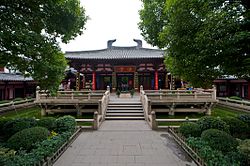| Dharma Hall | |||||||
|---|---|---|---|---|---|---|---|
 | |||||||
| Chinese name | |||||||
| Chinese | 法 堂 | ||||||
| |||||||
| Vietnamese name | |||||||
| Vietnamese alphabet | Pháp Đường | ||||||
| ChữHán | 法 堂 | ||||||
| Korean name | |||||||
| Hangul | 법당 | ||||||
| Hanja | 法堂 | ||||||
| |||||||
| Japanese name | |||||||
| Kanji | 法 堂 | ||||||
| |||||||
The Dharma Hall is a central building in East Asian Buddhist temples where teachings are delivered,scriptures are expounded,and assemblies are held. It serves as a space for disseminating Buddhist doctrines,often second in importance only to the Mahavira Hall. The hall typically features a elevated seat for the abbot or presiding monk,a lecture table,and symbolic decorations such as lion paintings (representing the "lion's roar" of Dharma propagation). Dharma Hall is called Fatang (法堂;Fǎtáng) in China,Hōdō(法堂) in Japan,Beopdang (법당) in Korea,and Pháp Đường in Vietnam.
